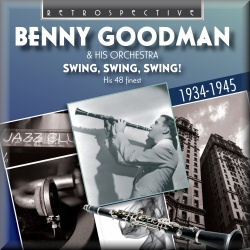CD1
1. Bugle Call Rag
2. Moonglow
3. Blue Skies
4. Sometimes I'm Happy
5. King Porter Stomp
6. It's Been So Long
7. Stompin' At The Savoy
8. Goody Goody
9. Get Happy
10. Christopher Columbus
11. I Know That You Know
12. Stardust
13. The Glory Of Love
14. I've Found A New Baby
15. These Foolish Things
16. Swingtime In The Rockies
17. You Turned The Tables On Me
18. Down South Camp Meeting
19. St. Louis Blues
20. Goodnight, My Love
21. Roll 'Em
22. Sugarfoot Stomp
23. Life Goes To A Party
24. Don't Be That Way
25. One O'Clock Jump
CD2
1. Big John's Special
2. I Let A Song Go Out Of My Heart
3. Bach Goes To Town
4. And The Angels Sing
5. There'll Be Some Changes Made
6. Stealin' Apples
7. Let's Dance
8. Darn That Dream
9. Honeysuckle Rose
10. How High The Moon
11. Taking A Chance On Love
12. Somebody Stole My Gal
13. Solo Flight
14. Air Mail Special
15. Clarinet … la King
16. Somebody Else Is Taking My Place
17. Jersey Bounce
18. A String Of Pearls
19. Why Don't You Do Right?
20. Mission To Moscow
21. Gotta Be This Or That
22. Sing, Sing, Sing
23. Goodbye
So much has been written about Benny Goodman and his music, with his records having been reviewed countless times both during his lifetime and since his passing in 1986, it is a challenge to try to find something new and interesting to say.
The period covered by this Retrospective two-CD set is 1934-1945, which was, in effect, the glory years of big band swing, and defined by two singular events: the Great Depression and World War II. Swing found its footing during these difficult times as it encouraged Americans to look on the bright side and tried to give comfort to the average person. Goodman, who was raised in the slums of Chicago, showed an early flair for the clarinet, which provided an escape from what would surely have been a life of manual labour. After a period of working as a sideman in bands as diverse as Ben Pollack and Ted Lewis, Goodman moved to New York where he would start his own band. Recognizing that in order to be successful, he would have to get away from uninspiring dance band arrangements, Goodman turned to black arrangers such as Fletcher Henderson and Edgar Sampson in order to build a book of Harlem-styled arrangements.
When 1935 rolled around, Goodman and the band were playing on a New York based US national radio programme called Let's Dance which featured them late in the evening when most New Yorkers had gone to bed. However in California they were playing in prime time and thus developed an unidentified fan base. So when the band hit the Palomar Ballroom in Los Angeles in August of 1935 and Benny called out King Porter Stomp, with Bunny Berigan on lead trumpet and Gene Krupa on drums, the crowd went wild and the swing era took off.
The 48 tracks that compose this two-CD set are in effect Goodman's best known tunes of this period. Therefore it might be more appropriate to comment only on a small number of these tracks. On CD1 which covers 1934-1938, Christopher Columbus, the Leon Berry composition, did not attain jazz feature status until it was inserted by Goodman as the derivative theme to his 1938 hit Sing, Sing, Sing which is offered in its entirety on CD2. It is often forgotten that Ella Fitzgerald as a nineteen-year-old, did a stint with the band and her 1936 version of Goodnight, My Love became a big hit. It is hard to overestimate the impact that Gene Krupa's drumming had on the band. Just listen as he drives the band along on Swingtime In The Rockies. The same might be said for Harry James' trumpet on Life Goes To A Party and Don't Be That Way.
CD2 is devoted to 1938-1945 and also has some gems amongst all the hits. After the success of And The Angels Sing at the 1938 Carnegie Hall Concert, Martha Tilton went into the studio in 1939 to record a version for the record-buying public. Although Ziggy Elman was still with the band, his merry trumpet interplay was with drummer Buddy Schutz not Gene Krupa. The Goodman theme Let's Dance, swings along with Benny's clarinet riding over the band with his usual virtuosity. Charlie Christian demonstrated his worth in the band with his terrific playing on Solo Flight. In 1942, Peggy Lee was just a twenty-two-year old who had been with the band for only a brief period. In her version of Why Don't You Do Right? listen to the phrasing and the enunciation of some of the words, and one could imagine Billie Holiday, who also had sung with Goodman early on. The biggest event in Goodman's career during this period was the 1938 Carnegie Hall Concert and from that concert Sing, Sing, Sing became the signature tune. However it was not until the 1950's with the release of the concert on a Columbia LP, that the magnitude of this rendition became apparent.
Benny Goodman was a clarinettist of unparalleled technique and swing. With his band, he christened the advent of the swing era, and these sides indicate just how influential he was during this period.
Pierre Giroux
